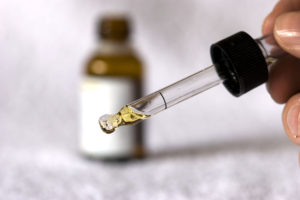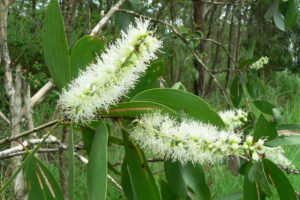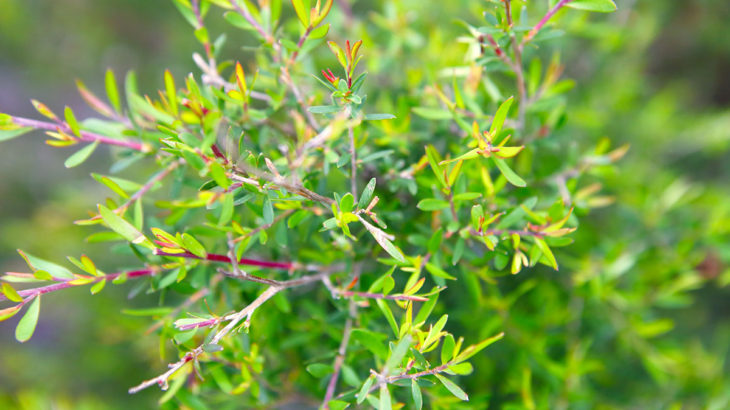Native to Australia, tea tree was named by the great explorer, Captain James Cook. It has been used by the Aboriginals for thousands of years to ward off colds and flu and to enjoy as a tea. Tea Tree Essential Oil is distilled from the leaves of the tea tree plant. It increases blood flow to the brain and is a valuable aid in overcoming depression and lifting physical and mental fatigue.
#10 of 10: Tea Tree Essential Oil
Tea tree, or Melaleuca alternifolia, is a large shrub up to 5-7 metres (16.5-30 feet). It has needle-like leaves and yellow or purple flowers that grow in the shape of a bottlebrush.
The name “tea tree” was invented by Captain James Cook, or one of his men, in or around the year 1777. The leaves of the tea tree were brewed by these first Australian settlers in hot water “to prevent scurvy”.
The first part of the scientific name Melaleuca alternifolia derives from the Greek words melos (dark, black) and leucon (white), and refers to the dark colour of the leaves and the relative whiteness of the paper-like, thin bark.
Tea tree belongs to the Myrtacea family of plants, with clove, eucalyptus, myrtle and others. The members of this plant family are known for their anti-infectious qualities.
Tea Tree Essential Oil Extraction

The Tea Tree Essential Oil is extracted by steam or water distillation from the leaves. The resulting liquid is pale yellow or clear, and has a pungent, sanitary odour.
Tea Tree Essential Oil blends admirably with lavandin, lavender, clary sage and other flower oils as well as some of the spice oils, such as clove and nutmeg.
Distribution and Early History
Tea tree is native to Australia, and does not tend to grow anywhere else. It is mostly found in New South Wales, on the east coast of the continent. It thrives in warm, wet climate and typically grows on swampy lands, and near rivers and drainage lines.
The healing properties of the tea tree plant were first discovered by the Australian aboriginals who boiled them in water for a tea. They might also chew fresh leaves or rub them between their hands to release the healthy vapours known to cure colds, headaches and coughs.
The Aboriginals used the fragile bark of the tea tree plant in building household utilities and other everyday items. It could also be utilised in roof-making as a thatching material.
The Tea Tree Essential Oil was first distilled in Australia in the 1920s, and subsequently studied by an Australian scientist, Dr. A.R. Penfold. According to his research findings from 1923, tea tree oil was 12 times more potent as a bactericide than carbolic acid, also known as phenol.
Active Ingredients of Tea Tree Essential Oil
The chemical composition of the Tea Tree Essential Oil is somewhat complicated, with a dozen or so constituents.
The most important active components include:
- 1,8-cineole (about 30% of the whole) and
- terpinen-4-ol (about 45%)
Other chemicals making up Tea Tree Essential Oil are, among others:
- alpha-pinene (2.1%)
- beta-pinene (0.4%)
- alpha-terpineol (5.3%)
- p-cymene (6.2%) and
- gamma-terpinene (15.7%)
Therapeutic Actions

Tea Tree Essential Oil is antiviral, antibacterial and—unlike many other essential oils—also antifungal. It is an immunostimulant as well as a cicatrisant, expectorant and a sudorific.
Tea Tree Essential Oil is an effective insecticide and can be used to repel insects.
Health Benefits
Tea Tree Essential Oil can be used to treat the immune, respiratory and genito-urinary diseases. It is effective as an antimicrobial and an antiseptic, and is commonly used as part of skin care.
Tea Tree Essential Oil is utilised in modern dental care, and it may be used in surgical operations. It has a strengthening effect on the patient when used to build up immunity before and after a surgery. Use it in baths and massage and alternate with lavender and bergamot.
Industrial uses of Tea Tree Essential Oil are many. It may be an ingredient in toothpastes, deodorants, disinfectants, gargles, soaps, germicides, colognes and aftershaves.
Among the mental benefits of Tea Tree Essential Oil is the decrease in the effects of depression, shock and hysteria. As an immune system booster, tea tree increases the body’s ability to repel diseases. It is used to treat colds, fever and childhood infections such as chickenpox.
Tea Tree Essential Oil is very good for people who fall ill frequently and are slow to recover. It is recommended for diseases of the genito-urinary system, and can be used to treat vaginal thrush, vaginitis and cystitis.
Tea Tree Essential Oil may heal hemorrhoids, as well as mouth infections. In skin care, it is used for acne, blisters, burns, cold sores, herpes, oily skin, plantar warts, wounds, nappy rash and general itching.
An important part of the healing arsenal of Tea Tree Essential Oil is its ability to cure fungal infections. In this capacity, it can be used to attack the athlete’s foot and Candida albicans (which may also manifest as vaginal thrush).
Finally, Tea Tree Essential Oil has a beneficial effect on the respiratory system and may be used to treat asthma, bronchitis, catarrh, coughs, sinusitis, and it may even have an effect on tuberculosis.
Mental Health Benefits

Tea Tree Essential Oil is recommended for individuals who are weak, either physically or mentally. It boosts up the defensive Qi and thus helps the body to rid itself of various pathogens. Frequency of infections is also decreased.
Tea Tree Essential Oil balances the nerves and increases blood flow to the brain. It lifts mental fatigue, builds confidence and dissipates the air of doom and gloom. According to Traditional Chinese Medicine, Tea Tree Essential Oil “fortifies lungs and bodily soul”. It helps in finding a positive attitude and fighting depression and victim mentality.
Application Methods
Tea Tree Essential Oil can used in massage, baths, sitz baths and douches. It can also be inhaled directly from the bottle or vapourised into the air in a diffuser.
For colds and influenza, put 3 or more drops into the bath water. Tea Tree Essential Oil will stimulate sweating which will encourage healing.
For cold sores, apply Tea Tree Essential Oil undiluted on the skin before a blister appears and as the tingling first starts.
To treat warts, put one drop in the centre of the wart and cover it with a bandaid. The treatment may take several weeks but will be effective if continued.
Safety

Tea Tree Essential Oil is generally safe to use, but may be sensitising to some people.
The oil must not be stored in clear containers which leads to oxidation of terpinen-4-ol chemical and an increase of para-cymene levels. The effects of damage to the oil may include skin irritation, erythema and oedema.
If the liquid is stored in amber or brown bottles, Tea Tree Essential Oil is non-irritant and non-toxic.
Shop for Tea Tree Essential Oil in store today >>








